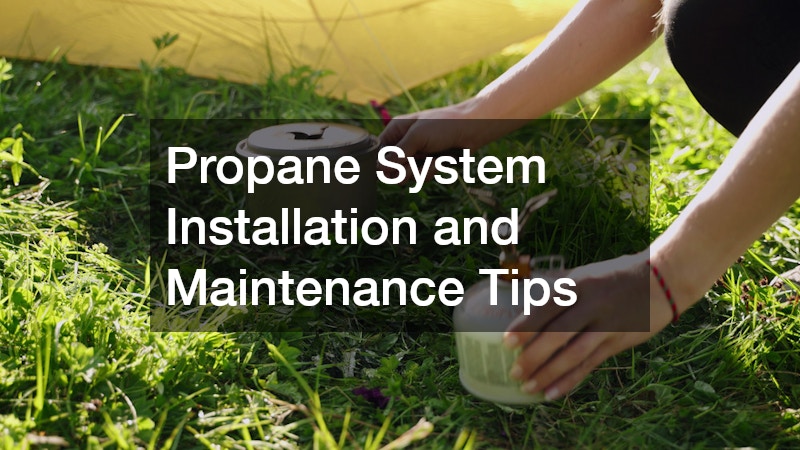In this article, we will discuss essential tips for installing and maintaining propane systems, ensuring safety and efficiency for your home or business. Propane has become a popular energy source due to its versatility, efficiency, and relatively low environmental impact. Proper installation and maintenance of propane systems are critical in preventing hazards and ensuring the system operates effectively.
What Are the Key Steps for Installing a Propane System?
This section will cover the critical steps involved in the proper installation of a propane system, including safety considerations and necessary equipment. The first step in a successful propane system installation is to perform an assessment of your property to determine the best location for the propane tank. Factors such as distance from buildings, potential hazards, and accessibility for delivery trucks must be considered. Additionally, it is essential to comply with local regulations and codes, as these may dictate specific requirements for installation.
Once a proper location has been identified, the installation of the propane tank must follow stringent safety protocols. A certified technician should be employed to install the system, as they will have the expertise to connect the tank to the home or business’s existing gas lines correctly. Using high-quality materials and components is critical for a safe and efficient installation. Any components used must be compatible with propane and meet industry standards.
How Often Should I Schedule Maintenance for My Propane System?
Learn about the recommended maintenance schedule for your propane system, including routine checks and what to look out for to ensure optimal performance. It is generally advised that homeowners and businesses schedule propane system maintenance at least once a year. This routine check-up includes examining connections, testing for leaks, inspecting appliances connected to the system, and ensuring that ventilation is adequate.
During these maintenance visits, technicians will review the entire propane system to identify any wear and tear or potential hazards that could compromise safety. Regular maintenance can help spot issues early, preventing costly repairs down the line. Additionally, this proactive approach ensures that your propane system operates efficiently and minimizes the risks associated with gas leaks or equipment malfunction.
Other aspects of maintenance may include cleaning or replacing filters, checking the condition of hoses and regulators, and testing safety features like shut-off valves. Homeowners should also take initiative between professional maintenance visits by routinely checking for any unusual odors or sounds from propane appliances. Keeping an eye on these issues can further enhance the safety and efficiency of your propane system.
What Safety Precautions Should Be Taken When Using Propane?
This section will explore the safety measures that should be implemented when using propane, including storage guidelines and emergency procedures. Safety is paramount when handling propane, as it is highly flammable and poses unique risks. One of the critical safety measures is to store propane tanks in a well-ventilated area, away from potential sources of ignition. Proper signage should also be displayed to inform of propane storage areas and any hazards associated with them.
Users should familiarize themselves with the odor of propane, which is often described as a “rotten egg” smell, to quickly detect leaks. In addition, it’s essential to have functional carbon monoxide detectors in place. These detectors provide an added layer of safety, alerting you to the presence of harmful gas before it reaches dangerous levels. Regularly testing and replacing batteries in these detectors is crucial for ensuring their functionality.
What Common Issues Arise with Propane Systems and How Can They Be Resolved?
Identify common problems that may occur with propane systems and effective solutions to address them promptly. One of the most frequent issues faced by users is fluctuating pressure levels, which can affect appliance performance. This problem can often be traced back to a malfunctioning regulator or a leak in the system. Immediate inspection and repair by a qualified technician are necessary to resolve pressure-related concerns and restore optimal operation.
Another common issue is the presence of leaks, which can pose serious safety risks. Users should always be aware of the signs of a leak, including the distinct odor of propane. If a leak is suspected, evacuating the area and contacting a professional is essential. Proper maintenance and inspections can significantly reduce the likelihood of leaks developing in the first place, making regular checks a practical preventative measure.
Finally, equipment malfunctions can also arise, often due to wear and tear or improper installation. Regular maintenance helps to catch these issues early, ensuring that all systems are functioning correctly. For any major equipment failures, consulting the user manual or contacting a professional for repairs will help in efficiently resolving the issue and restoring functionality to your propane system.
To summarize, following these tips for propane system installation and maintenance can help ensure the safety and efficiency of your system. By adhering to recommended installation guidelines, establishing a regular maintenance schedule, implementing essential safety precautions, and resolving common issues promptly, you can maintain a functional and safe propane system for your home or business. This approach ultimately provides peace of mind for all users, allowing you to enjoy the benefits of propane as a reliable energy source.
